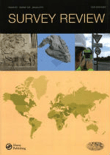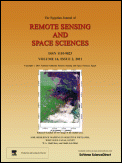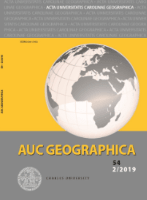
SURVEY REVIEW
Scope & Guideline
Connecting Disciplines Through Critical Insights and Research
Introduction
Aims and Scopes
- Geospatial Data Analysis:
The journal emphasizes methodologies for analyzing spatial data, including advanced techniques in Geographic Information Systems (GIS), remote sensing, and data mining, to improve decision-making in land management. - Land Administration and Governance:
A core focus is on the policies and practices surrounding land administration, including the legal frameworks, customary land rights, and innovative governance solutions that enhance land tenure security and inclusivity. - Precision Positioning Technologies:
Research on Global Navigation Satellite Systems (GNSS), including development and evaluation of positioning techniques, is a significant area. This includes innovations in precise point positioning (PPP) and real-time kinematic (RTK) methods. - Cadastral Systems and Innovations:
The journal explores advancements in cadastral systems, including digitization, modernization, and integration of international standards like the Land Administration Domain Model (LADM) for improved land management. - Environmental and Urban Studies:
Research related to urban planning and environmental monitoring, including the use of satellite data for assessing land use changes, urban deformation, and the impact of climate change on land resources. - Machine Learning and AI in Surveying:
The integration of machine learning techniques to enhance geospatial analysis, including applications in land cover classification and property valuation, is increasingly prominent in the journal's publications.
Trending and Emerging
- Integration of AI and Machine Learning:
There is a growing trend towards the application of artificial intelligence and machine learning techniques in surveying, particularly for automating data analysis and enhancing the accuracy of spatial assessments. - Sustainable Land Management Practices:
Research focusing on sustainable practices in land management is on the rise, highlighting the need for environmentally conscious approaches to land use that balance development with conservation. - Urban Deformation and Monitoring:
The study of urban deformation through advanced monitoring techniques, including the use of InSAR and GNSS, reflects an increasing interest in understanding the dynamics of urban environments under various stresses. - Blockchain Technology in Land Registration:
Emerging discussions around the use of blockchain for secure and transparent land registration processes indicate a trend towards innovative solutions for combating land tenure issues. - Fit-for-Purpose Land Administration:
The concept of fit-for-purpose land administration is gaining traction, promoting flexible, practical approaches tailored to local contexts, especially in developing regions. - Use of UAVs in Cadastral Updates:
The application of drone technology for efficient and cost-effective cadastral updates is becoming a prominent theme, showcasing the potential of UAVs in modern surveying practices.
Declining or Waning
- Historical Land Surveying Practices:
There is a noticeable decrease in publications focused on the historical aspects of land surveying, such as traditional methods and historical case studies, as contemporary issues take precedence. - Basic GNSS Techniques and Theories:
Research centered around foundational GNSS theories and techniques appears to be declining, as the field shifts towards more complex and integrated approaches that utilize multiple GNSS systems and advanced algorithms. - Manual Surveying Techniques:
With the rise of automated and technology-driven surveying methods, traditional manual techniques are receiving less emphasis in research, reflecting a broader trend towards automation in the surveying profession. - Local Case Studies in Isolated Contexts:
There is a waning interest in localized case studies that do not contribute to broader theoretical frameworks or do not integrate with global practices, as researchers increasingly seek to address universal challenges. - Conventional Cadastral Mapping Methods:
The focus on outdated cadastral mapping methods is diminishing, as more innovative and fit-for-purpose approaches are being developed and adopted in various regions.
Similar Journals

Egyptian Journal of Remote Sensing and Space Sciences
Fostering Global Collaboration in Earth and Space StudiesThe Egyptian Journal of Remote Sensing and Space Sciences, published by Elsevier, is a premier open-access journal dedicated to advancing the fields of Remote Sensing and Space Sciences. Since its inception, the journal has gained a prominent reputation, currently holding a prestigious Q1 ranking in Earth and Planetary Sciences and placing within the top 10% of its field according to Scopus metrics. With an ISSN of 1110-9823 and an E-ISSN of 2090-2476, the journal features a diverse range of scholarly articles that explore both theoretical and practical aspects of remote sensing technologies and space science innovations, thus appealing to researchers, professionals, and students alike. Established in 2003 and fully transitioning to an open-access model in 2010, the journal aims to disseminate knowledge and foster collaboration across the globe by providing wider accessibility to groundbreaking research findings. Its commitment to quality and innovation is a catalyst for intellectual development in these dynamic and evolving disciplines.

Journal of Geography-Chigaku Zasshi
Advancing Geographical Insights for a Changing WorldJournal of Geography - Chigaku Zasshi is a distinguished publication that serves as a crucial platform for the dissemination of research in the realm of geography and earth sciences. Published by the TOKYO GEOGRAPHICAL SOC in Japan, this journal is indexed with an ISSN of 0022-135X and an E-ISSN of 1884-0884. With a scope that includes Earth-Surface Processes, Geography, Planning and Development, Geology, Geophysics, and Global and Planetary Change, it provides comprehensive coverage of pressing geographical issues. Although it holds a Q4 ranking in multiple categories as of 2023, the journal presents an opportunity for researchers, professionals, and students to contribute meaningful findings in a diverse and competitive landscape. The Journal of Geography actively promotes scholarly dialogue by embracing the complexities of our planet and encouraging innovative approaches to geographical inquiries. This open-access journal aspires to bridge gaps and foster collaboration among scholars worldwide, underscoring its importance in understanding and addressing contemporary geographic challenges.

Journal of Applied Remote Sensing
Exploring the Future of Earth ObservationJournal of Applied Remote Sensing, published by SPIE-SOC PHOTO-OPTICAL INSTRUMENTATION ENGINEERS, stands at the forefront of research in the interdisciplinary field of applied remote sensing, focusing on innovative applications and advancements in technology that support our understanding of the Earth's systems. Established in 2007, this journal has quickly gained recognition, currently holding a Q2 ranking in the Earth and Planetary Sciences category, reflecting its influence and quality within the academic community, with a Scopus ranking of #68 out of 195 in General Earth and Planetary Sciences. The journal provides a robust platform for researchers, professionals, and students to disseminate their findings, ensuring open avenues for knowledge exchange in a field that increasingly impacts environmental monitoring, disaster management, and resource management. With its E-ISSN 1931-3195, the Journal of Applied Remote Sensing remains committed to advancing scholarly communication, fostering innovations that respond to real-world challenges, and enhancing remote sensing applications across diverse sectors. The journal operates from its headquarters in Bellingham, WA, USA, and aims to portray cutting-edge research that enriches the academic literature and informs policy and practice.

AUC Geographica
Exploring the Intersections of Earth and HumanityWelcome to AUC Geographica, a distinguished journal published by CHARLES UNIV PRAGUE, KAROLINUM PRESS, focusing on the expansive and interdisciplinary fields of Earth and Planetary Sciences, as well as Geography, Planning, and Development. With an ISSN of 0300-5402 and an E-ISSN of 2336-1980, this Open Access journal has been freely accessible since 2010, allowing researchers, professionals, and students to engage with high-quality scholarly articles without barriers. As of 2023, it holds a Q4 ranking in its respective categories, reflecting its commitment to contributing to the academic discourse despite competitive landscapes. Located in Prague, Czech Republic, at OVOCNY TRH 3/5, PRAGUE 1 116 36, AUC Geographica aims to foster collaboration and innovative research in the multifaceted relationships between human activities and the natural environment. With a publication history spanning from 1975 to 2024, this journal continues to be a vital resource for those seeking to advance knowledge and explore new dimensions in geography and Earth sciences.

Remote Sensing
Empowering Science with Open Access to Remote Sensing DiscoveriesRemote Sensing is a highly esteemed journal published by MDPI, dedicated to the domain of Earth and Planetary Sciences. With an impressive impact factor reflected in its rank of #16 out of 195 in the general Earth and Planetary Sciences category, this journal achieves a commendable 92nd percentile among its peers, indicating its significant contribution to the field. Since its inception in 2009 as an Open Access journal, it has enabled researchers, professionals, and students from around the globe to access high-quality, peer-reviewed articles that delve into the latest advancements in remote sensing technologies, methodologies, and applications. Based in Switzerland, Remote Sensing serves as a vital platform for disseminating innovative research that supports and enhances our understanding of Earth's processes and environments, ensuring scientific knowledge remains freely accessible and impactful.

Geomatik
Navigating the complexities of our environment through geomatics.Geomatik is a pioneering open-access journal dedicated to advancing the field of geomatics, encompassing disciplines such as geospatial data analysis, remote sensing, and geographic information systems. Founded in 2016 by the esteemed Geomatik Journal publisher, this peer-reviewed platform aims to disseminate high-quality research and innovative methodologies to a global audience. With its E-ISSN 2564-6761, Geomatik facilitates accessibility to cutting-edge studies that address vital challenges in environment monitoring, urban planning, and spatial data management. The journal not only encourages collaboration among researchers and practitioners but also serves as an essential resource for students seeking to deepen their understanding of geomatic sciences. Its commitment to open access fosters scholarly exchange and enhances visibility for authors, contributing to significant advancements within the geomatics community.

Applied Geomatics
Navigating the complexities of our planet through applied geomatics.Applied Geomatics is an esteemed academic journal published by SPRINGER HEIDELBERG, dedicated to advancing the field of geomatics through rigorous research and innovative applications. With an ISSN of 1866-9298 and an E-ISSN of 1866-928X, this journal has gained a prominent standing in multiple disciplines, achieving a Q2 ranking in esteemed categories such as Earth and Planetary Sciences, Engineering, Environmental Science, and Geography. The journal's convergence of research from 2009 to 2024 positions it as a vital resource for both scholars and practitioners seeking to understand and leverage geomatic technologies in real-world scenarios. Located in Germany, Applied Geomatics not only contributes to theoretical advancements but also to practical methodologies that address current environmental challenges. Its accessibility and relevance ensure that the findings discussed within its pages are pivotal for professionals, researchers, and students alike, fostering collaboration and innovation within the field.

Quaestiones Geographicae
Exploring the Boundaries of Geographical KnowledgeQuaestiones Geographicae, an esteemed open-access journal published by SCIENDO, serves as a vital platform for scholarly communication in the field of Earth and Planetary Sciences. Since its inception in 1979, the journal has been dedicated to promoting rigorous research and discourse in geography, encompassing a breadth of topics that reflect the dynamic nature of the discipline. With an impressive Impact Factor belonging to the Q3 quartile category, the journal actively contributes to the global scientific community's understanding of geographical phenomena. Its commitment to open-access publishing since 2010 ensures that groundbreaking research is accessible to a wider audience, facilitating collaboration and innovation. As part of its enduring legacy, Quaestiones Geographicae engages researchers, professionals, and students alike, inviting them to explore, share, and expand the boundaries of geographical knowledge.

EARTH
Pioneering discoveries in Earth and Environmental Sciences.EARTH is a prestigious journal published by MDPI, located in Switzerland, with a commitment to advancing the fields of Earth and Planetary Sciences and Environmental Science. Launched in 2020, the journal emphasizes an open-access publication model, ensuring that high-quality research is widely accessible to the scientific community and beyond. As of 2023, it proudly holds a Q2 ranking in both the Environmental Science and Earth and Planetary Sciences categories, indicating its significant impact within these disciplines; it ranks #90 out of 219 and #70 out of 159 in their respective fields according to Scopus. With the convergence of multidisciplinary research and the critical challenges our planet faces, EARTH seeks to publish innovative studies that foster a deeper understanding of geological and environmental processes. Researchers, professionals, and students alike will find this journal an invaluable resource for the latest findings and discussions shaping our understanding of Earth sciences.

Revista de Teledeteccion
Advancing remote sensing for a sustainable future.Revista de Teledeteccion, published by UNIV POLITECNICA VALENCIA, EDITORIAL UPV, is a leading Open Access journal dedicated to the interdisciplinary field of remote sensing and its applications. Since its inception in 2010, this journal has provided a vital platform for researchers, professionals, and students to disseminate groundbreaking findings, foster collaboration, and engage with contemporary challenges in Earth and Planetary Sciences as well as Geography, Planning, and Development. With a Q3 ranking in both fields as of 2023, it serves as an essential resource for advancing knowledge and innovative practices in hi-tech remote sensing methodologies. The journal covers a broad spectrum of topics, from satellite imaging techniques to environmental monitoring, making it an invaluable asset for those interested in harnessing remote sensing technologies to address real-world issues. The editorial office is located in Valencia, Spain, and the journal aims to bridge the gap between theoretical research and practical application, enriching the scientific community's understanding and capabilities in this dynamic domain.